Did you know that clogged drains are a common household issue? In fact, according to recent studies, over 75% of homeowners experience drain blockages at some point. But how can you tell if your drains are clogged? Well, there are several warning signs that indicate a potential problem. By recognizing these signs early on, you can take prompt action to prevent further damage and costly repairs. So if you notice any of these indications, it’s time to call in the experts and address the issue before it worsens.
Table of Contents
ToggleTop 5 Signs Your Drains Are About To Clog
Clogged drains can be a frustrating and inconvenient problem to deal with. To help you identify potential issues before they become full-blown clogs, here are the top five signs that your drains are about to clog:
1. Slow Drainage
Slow drainage is often the initial sign that your drain may be on the verge of clogging. It occurs when water takes an unusually long time to flow down the drain. This phenomenon is typically a result of obstructions within the plumbing system. These obstructions can be caused by a buildup of debris such as hair, soap scum, food particles, or mineral deposits inside the pipes. When such materials accumulate over time, they restrict the smooth flow of water, causing it to drain slowly.
Slow drainage can affect various fixtures in your home, including sinks, showers, bathtubs, and toilets. For instance, if your kitchen sink is draining sluggishly, it may be due to the accumulation of food particles and grease in the drainpipe. In the bathroom, slow drainage in the shower or bathtub can often be attributed to hair and soap scum buildup.
Recognizing slow drainage is relatively straightforward. You’ll notice the water level rising and taking longer than usual to subside when you use a particular fixture. Sometimes, you might even see water pooling around the drain. Additionally, a gurgling sound may occur as water struggles to pass through the partial blockage.
To prevent slow drainage from escalating into a full-blown clog, it’s advisable to take preventive measures. Regularly cleaning your drains using either chemical drain cleaners or natural remedies like baking soda and vinegar can help keep them clear. Installing drain strainers or catchers is also an effective way to prevent debris from entering the pipes in the first place. Addressing the issue of slow drainage promptly can save you from the inconvenience and potential plumbing damage associated with complete clogs. Ignoring this early warning sign may result in more serious blockages and the need for professional plumbing assistance.
2. Gurgling Sound
Unusual gurgling or bubbling sounds emanating from your drains, especially when you’re using other plumbing fixtures in your home, can be a clear indication that a clog might be developing within your plumbing system. These sounds are a consequence of air being trapped within the pipes due to an obstruction or partial blockage. Here’s a more detailed explanation:
These gurgling noises typically occur when water and air are trying to navigate around the blockage simultaneously. When you use a fixture like a sink, shower, or toilet, water and air should flow freely through the plumbing. However, when a clog forms, it disrupts this normal flow. As water attempts to pass the obstruction, it forces air to move along with it, creating the distinct gurgling or bubbling sounds you hear.
Additionally, gurgling sounds can also signify that the clog might be occurring in a main drain line shared by multiple fixtures. For example, if you flush the toilet and hear gurgling in the bathtub drain, it suggests a potential blockage in the main drain.
These auditory cues should not be ignored. They serve as a clear warning that there’s an issue in your plumbing that requires attention. Ignoring gurgling sounds can lead to a worsening clog or even more severe plumbing problems, such as sewage backups. To prevent such complications, it’s wise to investigate the source of the gurgling and take appropriate measures to clear the clog before it becomes a major inconvenience or expense.
3. Unpleasant Odor
Foul odors emanating from your drains are another sign that a clog may be developing within your plumbing system. These odors are often an indication of stagnant water, decomposing organic matter, or bacterial growth caused by the blockage. Here’s a more detailed explanation of this symptom:
When a clog or partial blockage occurs in your drain, it can trap debris, such as hair, soap scum, food particles, or other organic matter. Over time, these trapped materials decompose, providing a breeding ground for bacteria. The breakdown of these organic substances generates unpleasant odors that can permeate back into your living space through the drain.
The specific type of odor can vary depending on the source of the clog. For example, kitchen drains may produce a rotting or rancid smell due to decomposing food particles and grease buildup, while bathroom drains can emit a musty odor from the accumulation of soap scum, hair, and skin oils.
Unpleasant drain odors should not be dismissed as mere inconveniences. They are early warning signs of plumbing issues that require attention. Ignoring these odors can lead to the clog worsening and may even result in more severe problems like leaks or damaged pipes. To address the issue and prevent further complications, consider using drain cleaners or natural remedies to clear the blockage and remove the source of the odor. Additionally, maintaining good drain hygiene practices can help prevent these odors from recurring in the future.
4. Water Backing Up
Water backing up into other fixtures or drains when you use a specific plumbing fixture is a significant warning sign that a clog may be developing within your plumbing system. This symptom indicates an obstruction that is impeding the normal flow of wastewater. Here’s a more detailed explanation of this issue:
When you use a plumbing fixture, such as a sink, shower, bathtub, or toilet, the wastewater generated should flow smoothly through the drainage system and into the main sewer or septic tank. However, if there’s a blockage in the drainpipe or sewer line, the wastewater cannot pass freely. As a result, when you use one fixture, the water can back up into another one.
For example, if you flush the toilet and water starts to back up into the bathtub or shower drain, it suggests a potential blockage in the main drain line shared by these fixtures. This can happen because the wastewater from the toilet has nowhere to go due to the obstruction, causing it to flow backward into other drains.
Water backing up can be more than just an inconvenience; it can also be unsanitary, especially if sewage is involved. In such cases, it’s crucial to address the issue promptly to prevent sewage backups in your home, which can be a health hazard and cause significant damage. It’s advisable to call a professional plumber to inspect and clear the blockage in your plumbing system to prevent further complications. Ignoring this warning sign can lead to more severe issues that are costlier to repair.
5. Visible Accumulation
The presence of visible accumulation near the drain opening is another telling sign that your drains are at risk of clogging. This symptom is a direct visual indicator that debris is beginning to accumulate in the drain. Here’s a more detailed explanation of this warning sign:
As you use your sinks, showers, or bathtubs over time, various materials can find their way into the drain openings. This can include hair, soap scum, food particles, and other debris. When these substances accumulate near the drain, they create an initial barrier that impedes the smooth flow of water into the pipes. This accumulation may become noticeable when you observe a ring of debris or grime encircling the drain opening.
In bathroom sinks and showers, hair is a common culprit, as it easily gets caught in the drain. In kitchen sinks, food particles, and grease can accumulate near the drain. Additionally, in the case of showers or bathtubs, soap scum can build up, which is a combination of soap residue, minerals from water, and body oils.
Recognizing visible accumulation is a proactive way to prevent a full clog. If you notice debris near the drain, it’s an opportune moment to address the issue. You can manually remove the visible accumulation using a drain snake, or plunger, or by using a mixture of baking soda and vinegar to dissolve the material. Regular cleaning and maintenance of your drains can help prevent further accumulation and reduce the risk of clogs developing in the future. By addressing visible accumulation promptly, you can avoid the inconvenience and potential plumbing issues associated with fully clogged drains.
Recognizing And Addressing Clogged Drain Issues
In conclusion, it is crucial to be aware of the signs that indicate your drains are clogged. Slow drainage, foul odors, gurgling sounds, water backing up, and frequent clogs are all red flags that should not be ignored. By recognizing these signs early on, you can take proactive steps to address the issue before it becomes a major problem.
If you notice any of these signs in your home, don’t hesitate to take action. Ignoring a clogged drain can lead to more significant issues down the line, such as pipe damage or sewage backups. Call a professional plumber or try some DIY methods like using a plunger or drain snake to clear the blockage. Remember, prevention is key! Regularly maintaining your drains by avoiding pouring grease or food scraps down them and using drain screens can help prevent clogs from occurring in the first place.
Experience Excellence In Clogged Drain Solutions With Garcia Plumbing And Home Restoration!
We understand the frustrations homeowners face when dealing with clogged drains. Our dedicated team of licensed experts leads the way in providing exceptional clogged drain solutions that ensure reliability and efficiency.
Beyond just drain issues, Garcia Plumbing and Home Restoration offers comprehensive home maintenance solutions. Our reputation in Contra Costa County is built on unwavering quality, unmatched expertise, and the trust of numerous satisfied clients. Don’t compromise when it comes to your home’s functionality and cleanliness. Contact us today for an outstanding Clogged Drain service and embrace a worry-free plumbing future!




